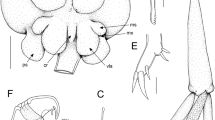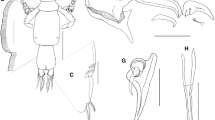Abstract
A new species of poecilostomatoid copepod, Hemicyclops spinulosus, is described from burrows of the ocypodid crab Macrophthalmus japonicus in an estuarine mud-flat in Tokyo Bay. The new species can be distinguished from its congeners by a combination of the segmentation and setation of first antenna, the ornamentation of maxilliped and the modified seta on the first segment of the endopod of legs 1–4.
Similar content being viewed by others
References
Ho, J.-S. & I.-H. Kim, 1990. Hemicyclops ctenidis, a new poecilostomatoid copepod (Clausidiidae) associated with a polychaete in Korea. Korean J. Zool. 33: 231–237.
Ho, J.-S. & I.-H. Kim, 1991. Two new species of the genus Hemicyclops (Copepoda: Poecilostomatoida: Clausidiidae) from crab burrows in Yellow Sea. Korean J. Zool. 34: 289–299.
Humes, A. G., 1984. Hemicyclops columnaris sp. n. (Copepoda: Poecilostomatoida: Clausidiidae) associated with a coral in Panama (Pacific side). Zool. Scr. 13: 33–39.
Vervoort, W. & F. Ramirez, 1966. Hemicyclops thalassius nov. spec. (Copepoda: Cyclopoida) from Mar del Plata, with revisionary notes on the family Clausidiidae. Zool. Meded., Leiden 41: 195–220.
Rights and permissions
About this article
Cite this article
Itoh, H., Nishida, S. A new species of Hemicyclops (Copepoda, Poecilostomatoida) from burrows of the ocypodid crab Macrophthalmus japonicus in an estuarine mud-flat in Tokyo Bay, Japan. Hydrobiologia 379, 85–92 (1998). https://doi.org/10.1023/A:1003423912372
Issue Date:
DOI: https://doi.org/10.1023/A:1003423912372




